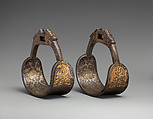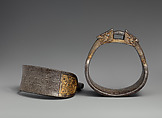Pair of Stirrups
Not on view
These stirrups are interesting as late examples in the continuum of traditional stirrups from the Tibetan plateau. The Metropolitan Museum of Art has a strong collection of distinctive stirrups from the fourteenth or fifteenth century through the eighteenth century and two pairs of stirrups made in the 1930s and 1940s for known patrons (2005.427.2a, b and 2008.81b, c). This pair appears to date from the mid to late nineteenth century or even early twentieth century, and bridges the gap between other examples in the Museum's collection, not only chronologically, but also in terms of form and style. They are unusual for the very streamlined, almost art deco, treatment of the dragonheads; for the prominent inclusion of qilin (so-called Chinese unicorns) in the decoration, a motif seldom found in a Tibetan context; for the style of the damascened decoration, reminiscent of late Tibetan and Chinese metalwork; and for the use of gold leaf, which is unusual, possibly unique, in the decoration of stirrups from this region. The weight, mass, and form also indicate their relatively late date and the changes that occurred in the design and construction of stirrup styles used on the Tibetan plateau in this period.
Due to rights restrictions, this image cannot be enlarged, viewed at full screen, or downloaded.
This artwork is meant to be viewed from right to left. Scroll left to view more.



